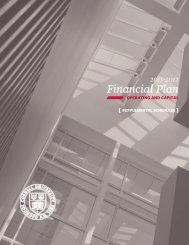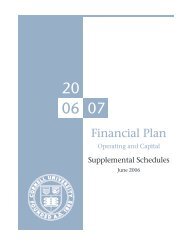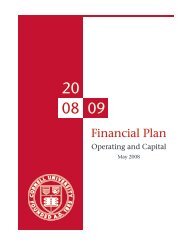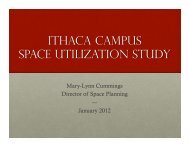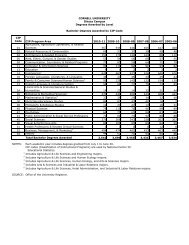2013-14 Operating & Capital Budget Plan - Cornell University ...
2013-14 Operating & Capital Budget Plan - Cornell University ...
2013-14 Operating & Capital Budget Plan - Cornell University ...
Create successful ePaper yourself
Turn your PDF publications into a flip-book with our unique Google optimized e-Paper software.
V<strong>Capital</strong> Project Spending GuidelinesUpdated August 2012Specific capital projects (including capital leases and third-party developer projects) maymove forward with the following restrictions.• With a very preliminary cost estimate, a unit may request to spend a limited amount of its own existing fundsthrough the normal PAR process, to the extent necessary to conceptually develop and size a project idea for thepurpose of advancing discussion for possible inclusion in the university’s approved five-year capital plan.• Before any formal design or construction work begins, the project must be included in the university’s approvedone-year capital budget. However, inclusion in the capital budget does not constitute authorization to proceedwith any phase of a project, which will be considered through the normal project approval process.Appendices• Before inclusion in the university’s approved five-year capital plan, the project must contain a submitted andapproved funding strategy which may not rely on uncertain sources of funding (e.g., gifts to be raised, grant proposals,future New York State capital plans) and which must include: 1) the full anticipated cost of the project, includingconstruction, architectural and design fees, equipment, contingencies, etc. – New York State fundedprojects may be divided between design and construction phases, with funding spanning SUNY capital plans; 2)the incremental annual cost of ongoing operations and maintenance for the facility; and 3) any other relevant information.Because funding sources are as diverse as university projects, each project’s funding strategy shouldbe developed with consideration given to both the project’s merit and university priorities.• The sources of funding for any additional operations and maintenance expenses must be identified, in writing.78• A project not included in the annual approved five-year capital plan may be brought forward for considerationas an addition to the capital plan if a full funding plan is identified between plan cycles. This determination willbe made by the <strong>Capital</strong> <strong>Plan</strong>ning Group (CPG) and <strong>Capital</strong> Funding & Priorities Committee (CF&PC).• Once included in the university’s approved five-year capital plan, preliminary work may be authorized throughthe schematic design phase if funded by existing available resources. Continuation of design work beyondschematic design and prior to approval of the construction phase may be permitted through the considerationand approval of CPG and CF&PC.Funding guidelines are as follows:• The university’s balance sheet expendable resources to debt ratio must always be greater than 2.0. If a newproject is added to the plan and brings the university below the minimum ratio, a trade-off decision mustbe made.- Until the university returns to the minimum expendable resources to debt ratio, there are no funds forlong or short term (bridge financing) debt.• No more than 50% of any capital project should be debt-financed unless the project is a life-safety or major infrastructurepriority. Auxiliary enterprises, such as dorms, will be evaluated based on the university’s overalldebt capacity.



